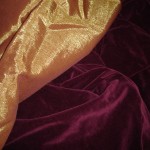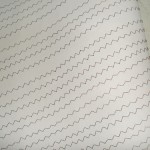
I took out my bodice block and traced off the pattern, tweaking it along the way. I cut a new mock up out of muslin/calico and fitted it. I don’t have any photos of the fitting, as I’ve been using the bodice block for some time now and finally have it more or less fitting me as it should. (But still I made mock ups as a just in case) The point hits where I felt it should, the back neckline had a slight arch like Elenora’s Funeral Gown. I only needed to take the shoulder straps up half an inch.
The red line in the photo is where my waist is and I marked where the neckline will hit once the seam allowances are turned down.
I then dated and labeled the pattern to save my sanity.
It is spring, it makes me want to clean and that usually means cleaning out the sewing boxes. Throwing out random bits of muslin that you can’t remember using the past few months and then a few days later realizing it was a Useful pattern you had mocked up. Hence why I label my mock ups, and usually transfer them to card.


For the gown I have 6 yards of velvet, and cotton blend that will look great as the lining. Usually I would cut out the skirt sew it, and then on to the bodice and sleeves. But to shake things up a bit I’m going for the bodice first. It is smaller, I plan to sew it mostly by hand and I have several options open for how to go about it.
In the test dress I relied upon an interlining of twill and narrow plastic boning to give the bodice structure. This worked well, it kept the bodice point from curling up and I’ve used it in other costumes with no problem. But there is very little evidence of boning being used in Florentine fashion at this point in history. Moda a Firenze mentions the use of stiff linen, felts, bombast and even cardboard to give that smooth flat shape to gowns.

The use of stays or a corset under the gown is also debatable.
Anea has written a good article upon the matter of Renaissance stays in Italian Fashion. Her write up, and the lack of a mention of stiffening in Eleanora’s wardrobe accounts leads me away from using boning.
With all this in mind I gathered up my materials, due to cost, availability, and comfort I substituted cotton drill in place of linen, thin buckram and cotton quilt batting as bombast in place of wool felt.
(Trying to find 100% wool anything in Florida.. it doesn’t happen too often.)
To start I traced my pattern out onto muslin which will be a base layer for everything else. It will eventually be basted to the velvet fabric, helping support it and giving me very little bulk in the seam allowances.

Next came the twill and buckram layer, which I cut without straps but with seam allowance, which will but cut away later. These two layers were machine zig-zagged together, and then zig-zagged to the muslin to prevent the layers from shifting.
Usually these layers would be basted or pad-stitched together, but as they were not providing shaping and to save time I used the sewing machine.

The twill and buckram gave the bodice a paper feeling stiffened shape, and I knew from making the Unicorn Gown, I could at times use just those layers to stiffen the bodice.
But would it work with this style of gown?
I was also starting to wonder about the layers of bombast and how warm it might be.
So I tried it on with just the twill and buckram layers.
If fitted well, but after some wearing and perhaps due to my lack of good posture, wrinkles started to develop just under the bust.
I still didn’t want to add boning so I cut out my layers of bombast and started pad-stitching them together by hand.